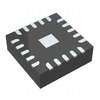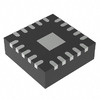Manufacturer Part Number
TPS51427RHBR
Manufacturer
Texas Instruments
Introduction
The TPS51427RHBR is a specialized power management integrated circuit (PMIC) for notebook power systems, featuring Texas Instruments' D-CAP™ mode for fast transient response.
Product Features and Performance
Dual-channel synchronous step-down controller
Supports D-CAP™ mode for both outputs
DC voltage accuracy: ±1%
180° out-of-phase operation
Selectable switching frequency from 200kHz to 680kHz
Adaptive on-time control architecture
Support for pre-biased startup
Built-in power-good indicator
Product Advantages
Improved system response and fast load-transient performance
Reduction in the number of external components due to D-CAP™ mode operation
High efficiency and low power consumption
Suitable for use in space-constrained applications
Key Technical Parameters
Voltage - Input: 5.5V to 28V
Number of Outputs: 2
Voltage - Output: 3.3V, 5V, Adjustable
Operating Temperature: -40°C to 85°C
Mounting Type: Surface Mount
Package/Case: 32-VFQFN Exposed Pad
Supplier Device Package: 32-VQFN (5x5)
Quality and Safety Features
Built-in overvoltage protection
Overcurrent and thermal protection features
Under-voltage lockout (UVLO)
Compatibility
Compatible with multiple notebook power system designs
Can be used with a variety of external components to adjust output voltage and current parameters
Application Areas
Notebook computers
Power supply units
Portable electronics with emphasis on energy efficiency
Product Lifecycle
Status: Active
Not currently listed as nearing discontinuation
Information about replacements or upgrades should be sought directly from Texas Instruments’ updates
Several Key Reasons to Choose This Product
Highly integrated solution reduces complexity and can save PCB space
Energy-efficient design contributes to longer battery life in portable applications
Versatile input voltage range supports a broad array of power sources
Texas Instruments' reliability and support for power management solutions
Adaptive on-time control enables excellent transient response with minimal external components



 TPS51461RGETTexas InstrumentsIC REG BUCK PROG 6A 24VQFN
TPS51461RGETTexas InstrumentsIC REG BUCK PROG 6A 24VQFN TPS51396ARJERTexas InstrumentsIC REG BUCK ADJ 8A 20QFN
TPS51396ARJERTexas InstrumentsIC REG BUCK ADJ 8A 20QFN TPS51397ARJERTexas Instruments4.5-V TO 24-V INPUT, 10-A, SYNCH
TPS51397ARJERTexas Instruments4.5-V TO 24-V INPUT, 10-A, SYNCH